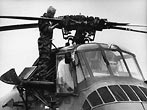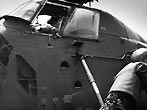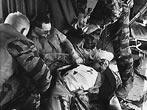
  
  
  
  
  
  
  
  
  
  
  
  
  
  
  
  
  
  
  
  
  
  
  
  
  
  
|
 |
16 April 1965 - One Ride With Yankee Papa 13
Larry Burrows’ Classic Photo Essay: ‘One Ride With Yankee Papa 13′
A mortally wounded comrade at his feet, Lance Cpl. James C. Farley, helicopter crew chief, yells to his pilot while in flight after a firefight in Vietnam, 1965.
In the spring of 1965, within weeks of 3,500 American Marines arriving in Vietnam, a 39-year-old Briton named Larry Burrows began work on a feature for LIFE magazine, chronicling the day-to-day experience of U.S. troops on the ground — and in the air — in the midst of the rapidly widening war. The photographs in this gallery focus on a calamitous March 31, 1965, helicopter mission; Burrows’ “report from Da Nang,” featuring his pictures and his personal account of the harrowing operation, was published two weeks later as a now-famous cover story in the April 16, 1965, issue of LIFE.
Over the decades, of course, LIFE published dozens of photo essays by some of the 20th century’s greatest photographers. Very few of those essays, however, managed to combine raw intensity and technical brilliance to such powerful effect as “One Ride With Yankee Papa 13″ — widely regarded as the single greatest photographic achievement to emerge from the war in Vietnam.
Here, LIFE presents Burrows’ seminal photo essay in its entirety: all of the photos that appeared in LIFE are here. (Left: In a picture from the article, Burrows mounts a camera to a special rig attached to an M-60 machine gun in helicopter YP13 — a.k.a., “Yankee Papa 13.”)
NOTE: At the end of this gallery, after slide 23, there are three previously unpublished photographs from Burrows’ 1965 assignment.
Burrows, LIFE informed its readers, “had been covering the war in Vietnam since 1962 and had flown on scores of helicopter combat missions. On this day he would be riding in [21-year-old crew chief James] Farley’s machine — and both were wondering whether the mission would be a no-contact milk run or whether, as had been increasingly the case in recent weeks, the Vietcong would be ready and waiting with .30-caliber machine guns. In a very few minutes Farley and Burrows had their answer.”
The following paragraphs — lifted directly from LIFE — illustrate the vivid, visceral writing that accompanied Burrows’ astonishing images, including Burrows’ own words, transcribed from an audio recording made shortly after the 1965 mission:
“The Vietcong dug in along the tree line, were just waiting for us to come into the landing zone,” Burrows reported. “We were all like sitting ducks and their raking crossfire was murderous. Over the intercom system one pilot radioed Colonel Ewers, who was in the lead ship: ‘Colonel! We’re being hit.’ Back came the reply: ‘We’re all being hit. If your plane is flyable, press on.’
“We did,” Burrows continued, “hurrying back to a pickup point for another load of troops. On our next approach to the landing zone, our pilot, Capt. Peter Vogel, spotted Yankee Papa 3 down on the ground. Its engine was still on and the rotors turning, but the ship was obviously in trouble. ‘Why don’t they lift off?’ Vogel muttered over the intercom. Then he set down our ship nearby to see what the trouble was.
“[Twenty-year-old gunner, Pfc. Wayne] Hoilien was pouring machine-gun fire at a second V.C. gun position at the tree line to our left. Bullet holes had ripped both left and right of his seat. The plexiglass had been shot out of the cockpit and one V.C. bullet had nicked our pilot’s neck. Our radio and instruments were out of commission. We climbed and climbed fast the hell out of there. Hoilien was still firing gunbursts at the tree line.”
Not until YP13 pulled away and out of range of enemy fire were Farley and Hoilien able to leave their guns and give medical attention to the two wounded men from YP3. The co-pilot, 1st Lt. James Magel, was in bad shape. When Farley and Hoilien eased off his flak vest, they exposed a major wound just below his armpit. “Magel’s face registered pain,” Burrows reported, “and his lips moved slightly. But if he said anything it was drowned out by the noise of the copter. He looked pale and I wondered how long he could hold on. Farley began bandaging Magel’s wound. The wind from the doorway kept whipping the bandages across his face. Then blood started to come from his nose and mouth and a glazed look came into his eyes. Farley tried mouth-to-mouth resuscitation, but Magel was dead. Nobody said a word.”
In his searing, deeply sympathetic portrait of young men fighting for their lives at the very moment America is ramping up its involvement in Southeast Asia, Larry Burrows’ work anticipates the scope and the dire, lethal arc of the entire war in Vietnam.
Six years after the “Yankee Papa 13″ photo essay ran in LIFE, Burrows was killed, along with three other journalists — Henri Huet, Kent Potter and Keisaburo Shimamoto — when a helicopter in which they were flying was shot down over Laos in February, 1971. He was 44 years old.
Source: www.life.time.com
Photography by Larry Burrows—Time & Life Pictures/Getty Images
01 - "Daybreak found them on the flight line," LIFE reported. "Farley's last-minute checks were painstaking. At last everything was shipshape."
02 - The next gut wrenching set is pretty famous for it made the cover of LIFE in 1965. It's the story of USMC helicopter Yankee Papa 13 of HMM-163.
03 - Heli check-up before the mission. Lance Cpl. James C. Farley and PFC Wayne Hoilien give their aircraft (YP13) a stem to the stern going-over.
04 - Mission briefing at Da Nang: to airlift an ARVN infantry battalion into the Que Son Valley.
05 - Photographer Larry Burrows fastens a camera to Farley's machine gun.
06 - ARVN troops board the Helicopter.
07 - Inside Yankee Papa 13, one of 17 copters making up the mission, with the pilot and co-pilot buckled in at the controls, gunner Hoilien fits an ammo belt into his M-60 machine gun.
08 - After standing outside the copter, giving the thumbs-up signal for take-off, Farley ducked into the belly door and took his place at a gun station. Twenty-five minutes later, Yankee Papa 13 picked up its cargo of troops. With nine South Vietnamese soldiers and Burrows aboard, the cabin of the copter was close and sweaty. "But there was a fine breeze aloft," LIFE reported, "and for that all were grateful."
09 - As Yankee Papa 13 approaches the landing zone, crew chief Farley opens fire with his M-60 machine gun at Vietcong positions. Larry Burrows took this picture with a camera mounted outside the copter on a special rig attached to the gun. As the gun swiveled, so did the rig, thus keeping the camera always pointed directly at Farley. Burrows triggered the camera by remote cable while squatting out of sight behind Farley.
10 - ARVN soldiers and Farley on the way to the combat assault.
11 - Yankee Papa 13 touches down and Farley holds his fire as South Vietnamese soldiers scramble past his machine gun to join their comrades, who were jumping out of other copters for an assault against the Vietcong.
12 - ARVN jump out of YP13. The view from inside Marine helicopter Yankee Papa 13, Vietnam, March 1965.
13 - Sgt. Owens, wounded crew-chief of YP3 runs toward Farley. The caption that accompanied this photograph in the April 16, 1965, issue of LIFE: "From the downed YP3 in the background, the wounded gunner, Sergeant Owens, races to Yankee Papa 13, where Farley waits in the doorway."
14 - "In the cockpit of YP3 we could see the pilot slumped over the controls," Burrows recalled shortly after the mission, his words transcribed from an audio recording and published alongside his own pictures in LIFE. "'Farley,' Captain Vogel said, 'see what you can do for that other pilot.' Farley barreled out of the copter and raced over to Yankee Papa 3. I chased after him. From a stone building some 70 yards away a Vietcong machine gun was spraying the area. Farley scrambled up to the pilot (above) and fought to drag him out, but he couldn't be budged."
15 - "Farley switched off YP3's engine," Burrows said. "I was kneeling on the ground alongside the ship for cover against the V.C. fire. Farley hastily examined the pilot. Through the blood around his face and throat, Farley could see a bullet hole in the neck. That, plus the fact the man had not moved at all, led him to believe the pilot was dead. Machine-gun bullets were tearing holes into the aircraft's skin all around Farley. It would have been certain death to hang around any longer. So, crouching low, we ran back to Yankee Papa 13."
16 - Farley tries to get the seriously wounded Lieutentant Magel, co-pilot of YP3 out of the cockpit.
17 - The caption that accompanied this photograph in LIFE: "Farley, unable to leave his gun position until YP13 is out of enemy range, stares in shock at YP3's co-pilot, Lieutenant Magel, on the floor."
18 - This photo's caption, from LIFE: "Farley opens a first-aid kit to apply to Magel's wound as Hoilien watches Owens, the wounded gunner (with dark glasses), slumped in the rear."
19 - Exhausted by the strain, Farley stands over Magel's body while Hoilien (back to camera) tries to comfort Owens.
20 - "The other wounded man, Sgt. Billie Owens, his left shoulder smashed by a bullet, lay in shock against the bulkhead," Burrows said. "He was watching, but his sunglasses hid any expression his eyes might have shown. Farley poured some water into an empty ammunition can and gave it to Owens. Hoilien took out a cigarette for him, but Owens waved it aside. We were all left with our own drained thoughts."
21 - "Suddenly," Burrows remembered, "at the doorway of the chopper, Farley began cursing. Then he broke into tears, first trying to cover his face from the others and then not caring who saw him. I don't know what this young man may have seen of violent death before this day. But compounding his grief and shock, I later found out, were his frustration and feelings of guilt at being unable to extricate the pilot from Yankee Papa 3. What he didn't know then, and what we all were to learn later, was that the pilot was still alive. He was rescued by another helicopter even as YP13 was en route to Da Nang."
22 - Farley talks to his own pilot, Captain Vogel, about the pilot who had to be left behind in YP3. "If we had stayed another 10 seconds under those V.C. machine guns," Vogel said, "you or us would never have got out of there."
23 - Back at Da Nang, wounded Sergeant Owens is eased out of the copter by Farley and a fellow Marine.
24 - Farley and Hoilien, dead tired, linger beside their helicopter and continue to talk over the mission.
25 - In a supply shack, hands covering his face, an exhausted, worn James Farley gives way to grief.
26 - Unpublished. A Larry Burrows photograph from Vietnam, March, 1965, not published in the original "Yankee Papa 13"
|